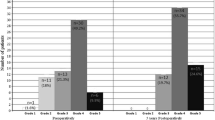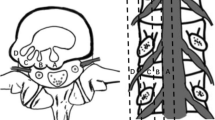Abstract
Our aim was to establish the normal range of MRI findings after successful lumbar discectomy. We prospectively examined 34 consecutive patients with an excellent clinical outcome by MRI 6 weeks and 6 months after surgery. All examinations included sagittal and axial spin-echo (SE) T1-weighted images before and after intravenous gadolinium-DTPA and fast SE T2-weighted images. Contrast enhancement along the surgical tract was seen in all patients 6 weeks and 6 months after surgery. After 6 months minimal or no mass effect on the dural sac by epidural scar was seen. In 20% of patients there was recurrent disc herniation, with mass effect. Enhancing nerve roots were seen in 20% of patients 6 weeks postoperatively, and half of these were associated with recurrent disc herniation at the same side. None of these patients still showed nerve root enhancement 6 months after surgery. Postoperative MRI studies must be interpreted with great care since the features described in the failed back surgery syndrome are also found, to some extent, in asymptomatic postoperative patients.
Similar content being viewed by others
References
Rish BL (1984) A critique of the surgical management of lumbar disc disease in a private neurosurgical practice. Spine 9: 500–504
Weber H (1978) Lumbar disc herniation. A prospective study of prognostic factors including a controlled trial. Part I. J Oslo City Hosp 28: 36–61
Weber H (1978) Lumbar disc herniation. A prospective study of prognostic factors including a controlled trial. Part II. J Oslo City Hosp 28: 89–103
Abramovitz JN, Neff SR (1991) Lumbar disc surgery: results of the prospective lumbar discectomy study of the Joint Section on Disorders of the Spine and Peripheral Nerves of the American Association of Neurological Surgeons and the Congress of Neurological Surgeons. Neurosurgery 29: 301–307
Cervellini P, Curri D, Volpin L, et al (1988) Computed tomography of epidural fibrosis after discectomy: a comparison between symptomatic and asymptomatic patients. Neurosurgery 23: 710–713
Hudgins PA, Clare CE (1990) Radiographic evaluation of the patient with failed back surgery syndrome (FBSS). Cont Neurosurg 12: 23
Hueftle MG, Modic MT, Ross JS, et al (1988) Lumbar spine: postoperative MR imaging with Gd-DTPA. Radiology 167: 817–824
Bundschuh CV, Modic MT, Ross JS, Masaryk TJ, Bohlman H (1988) Epidural fibrosis and recurrent disk herniation in the lumbar spine: MR imaging assessment. AJNR 9:169–178, AJR 150:923–932
Frocrain L, Duvauferrier R, Husson J-L, Noel J, Ramee A, Pawlotsky Y (1989) Recurrent postoperative sciatica: evaluation with MR imaging and enhanced CT. Radiology 170: 531–533
Sotiropoulos S, Chafetz NI, Lang P, et al (1989) Differentiation between postoperative scar and recurrent disk herniation: prospective comparison of MR, CT, and contrast-enhanced CT. AJNR 10: 639–643
Firooznia H, Kricheff II, Rafii M, Golimbu C (1987) Lumbar spine after surgery: examination with intravenous contrast-enhanced CT. Radiology 163: 221–226
Finnegan WJ, Fenlin JM, Marvel JP, Nardini RJ, Rothman RH (1979) Results of surgical intervention in the symptomatic multiply-operated back patient. Analysis of sixty-seven cases followed for three to seven years. J Bone Joint Surg [Am] 61: 1077–1082
Braun IF, Hoffman JC Jr, Davis PC, et al (1985) Contrast enhancement in CT differentiation between recurrent disk herniation and postoperative scar: prospective study. AJNR 6: 607–612
Bundschuh CV, Stein L, Slusser JH, Schinco FP, Ladaga LE, Dillon JD (1990) Distinguishing between scar and recurrent herniated disk in postoperative patients: value of contrast-enhanced CT and MR imaging. AJNR 11: 949–958
Tullberg T, Grane P, Rydberg J, Isacson J (1994) Comparison of contrast-enhanced computed tomography and gadolinium-enhanced magnetic resonance imaging one year after lumbar discectomy. Spine 19: 183–188
Montaldi S, Fankhauser H, Schnyder P, Tribolet N de (1988) Computed tomography of the postoperative intervertebral disc and lumbar spinal canal: investigation of twenty-five patients after successful operation for lumbar disc herniation. Neurosurgery 22: 1014–1022
Braun IF, Lin JP, Benjamin MV, Krichiff II (1983) Computed tomography of the asymptomatic postsurgical lumbar spine: analysis of the physiological scar. AJNR 4: 1213
Spallone A, Martino V, Floris R (1993) The role of early postoperative CT scan following surgery for herniated lumbar disc. Acta Neurochir 123: 52–56
Boden SD, Davis DO, Dina TS, et al (1992) Contrast-enhanced MR imaging performed after successful lumbar disk surgery: prospective study. Radiology 182: 59–64
Deutsch AL, Howard M, Dawson EG, et al (1993) Lumbar spine following successful surgical discectomy. Magnetic resonance imaging features and implications. Spine 18: 1054–1060
Tullberg T, Grane P, Isacson J (1994) Gadolinium-enhanced magnetic resonance imaging of 36 patients one year after lumbar disc resection. Spine 19: 176–182
Prolo DJ, Oklund SA, Butcher M (1986) Toward uniformity in evaluating results of lumbar spine operations. A paradigm applied to posterior lumbar interbody fusions. Spine 11: 601–606
Kischer WC, Shetlar MR (1979) Microvasculaturein hypertrophic scars and the effects of pressure. J Trauma 19: 757–764
Bundschuh CV (1993) Imaging of the postoperative lumbosacral spine. Neuroimag Clin North Am 3: 499–516
McCarron RF, Wimpee MW, Hudkins PG, Laros GS (1987) The inflammatory effect of nucleus pulposus. A possible element in the pathogenesis of low-back pain. Spine 12: 760–764
Murray JG, Stack JP, Ennis JT, Behan M (1994) Digital substraction in contrast-enhanced MR imaging of the postoperative lumbar spine. AJR 162: 893–898
Author information
Authors and Affiliations
Rights and permissions
About this article
Cite this article
Van Goethem, J.W.M., Van de Kelft, E., Biltjes, I.G.G.M. et al. MRI after successful lumbar discectomy. Neuroradiology 38 (Suppl 1), S90–S96 (1996). https://doi.org/10.1007/BF02278130
Received:
Accepted:
Issue Date:
DOI: https://doi.org/10.1007/BF02278130




